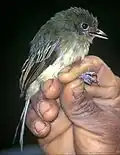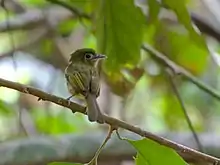| Rhynchocyclus | |
|---|---|
 | |
| Western olivaceous flatbill (R. aequinoctialis) | |
| Scientific classification | |
| Domain: | Eukaryota |
| Kingdom: | Animalia |
| Phylum: | Chordata |
| Class: | Aves |
| Order: | Passeriformes |
| Family: | Tyrannidae |
| Genus: | Rhynchocyclus Cabanis & Heine, 1860 |
| Type species | |
| Rhynchocyclus olivaceus | |
| Species | |
|
5, see text | |
| Synonyms | |
Rhynchocyclus is a genus of tyrant flycatchers. Established by Jean Cabanis in 1836.
Species
It contains five species:[1]
| Image | Scientific name | Common Name | Distribution |
|---|---|---|---|
 | Rhynchocyclus brevirostris | Eye-ringed flatbill | Belize, Colombia, Costa Rica, El Salvador, Guatemala, Honduras, Mexico, Nicaragua, and Panama, with a slight incursion into Colombia |
.jpg.webp) | Rhynchocyclus pacificus | Pacific flatbill | Colombia and Ecuador. |
.jpg.webp) | Rhynchocyclus olivaceus | Eastern olivaceous flatbill | Brazil, Colombia, French Guiana, Guyana, Suriname, and Venezuela. |
 | Rhynchocyclus aequinoctialis | Western olivaceous flatbill | Bolivia, Colombia, Ecuador, Panama, Peru, and Venezuela. |
 | Rhynchocyclus fulvipectus | Fulvous-breasted flatbill | Bolivia, Colombia, Ecuador, Peru, and Venezuela. |
The name Rhynchocyclus is a combination of the Greek words rhunkhos, meaning "bill" and kuklos, meaning "circle" or "shield".[2]
References
- ↑ Gill, Frank; Donsker, David, eds. (2019). "Tyrant flycatchers". World Bird List Version 9.2. International Ornithologists' Union. Retrieved 29 June 2019.
- ↑ Jobling, James A. (2010). The Helm Dictionary of Scientific Names. London, UK: Christopher Helm. p. 335. ISBN 978-1-4081-2501-4.
This article is issued from Wikipedia. The text is licensed under Creative Commons - Attribution - Sharealike. Additional terms may apply for the media files.